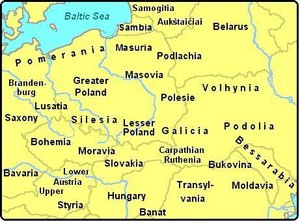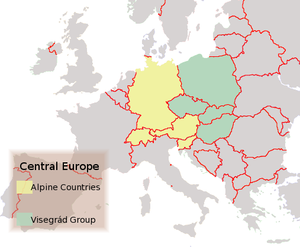Central Europe
|
|
Central Europe is the region of Europe between Eastern Europe and Western Europe. There are no physical landmarks that would commonly be seen as its borders. Rather, it is a concept of shared history, in opposition against the East represented by the Ottoman Empire and Imperial Russia, and up to World War I distinguished from the West as the area of relative political conservatism opposing the modern liberal ideas acquired by overseas trading; and ultimately from the French Revolution. Following World War I, and even more so after World War II, these modern ideas in general, and liberal democracy in particular, expanded its dominance to Austria and Germany.
The concept of Central Europe has recently not been much used, shadowed by Eastern and Western Europe. It may be seen in historical and cultural contexts, where it denotes the area where Germans settled and mixed with Slavs and Magyars, and where Roma and Jewish minorities made important cultural contributions. This notion has lost much of its relevance due to the Holocaust and the following ethnic division over the Oder-Neisse line with Germans transferred to the West both in physical and ideological sense. The term is being increasingly used again, with the recent expanses of European Union.
Some used to joke that Central Europe is that part of the continent that is considered eastern by Western Europe and western by Eastern Europe.
| Contents |
Between the Alps and the Baltics
According to several English-language encyclopedias, such as the Encyclopædia Britannica, the 1911 Encyclopædia Britannica and the Columbia Encyclopedia, as well as the CIA World Factbook, the term Central Europe is taken to include:
|
Alpine countries | ||
|
Visegrád group |
In the article on Europe, the 1913 Catholic Encyclopedia counts Germany (that then reached east of the Baltic) but not Switzerland to Central Europe; Liechtenstein is not mentioned. In other articles of that encyclopedia, France and Switzerland are included.
The notion of Alpine Countries extending to the Baltic Sea and the North Sea is not uncontroversial. While Germany without any doubt formerly has been considered a Central European land, both by Germans and by others, it has at least for the 19th and 20th century had an identity and self-image as located North of the Alps rather than in the Alps. This holds true even for Bavaria, the most Alpine of the German states, where most people live below the Alps.
Culturally Central-European
Several other countries also have regions that retain a Central European character, having historically been part of the central European kingdoms and empires such as the Holy Roman Empire, the Habsburg monarchy, the Polish-Lithuanian Commonwealth, and Imperial Germany. They include:
- Belarus (western parts)
- Croatia (Slavonia and the northwest part of the country)
- Lithuania
- Romania (Transylvania and Banat)
- Serbia (Vojvodina)
- Ukraine (Galicia)
Central Europe behind the Iron Curtain
Following World War II, large parts of Europe that were western in culture and history became part of the Eastern bloc, which effectively neutralized the concept of Central Europe. Following the fall of the Iron Curtain and the end of the Cold War, this distinction has again come into use, often to cover those countries that had been Soviet satellites but are now members of NATO and the European Union, reflecting remaining differences between countries that were East and West of the Iron Curtain.
The English term Central Europe was increasingly applied only to the countries east of the Iron Curtain (Poland to Hungary) to specify them as culturally akin countries under Soviet hegemony. This usage continued after the fall of the Iron Curtain when these countries started to undergo transition.
In everyday usage, this is the most common meaning of Central Europe, not least among Central Europeans for whom it is often important to point out the difference to that "Eastern Europe" that they otherwise are grouped together with.
So defined, the following countries are entirely included:
Usually excluded are:
- the Baltic countries
- Russian Orthodox and Muslim lands
- the Balkans
Although Slovenia as a part of Yugoslavia was strictly speaking neither a Soviet satellite nor a member of the Warsaw Pact, Slovenia's 20th century history has much in common with that of the other Central European countries. East Germany, on the other hand, was 1949–1990 both a true Soviet satellite and a loyal member of the Warsaw Pact, but would rather be seen as the last inheritors of Protestant Prussian culture than of Catholic Central European.
The new members of the European Union
After the enlargement of the European Union of 1 May 2004, the term Central Europe is sometimes used in a way that rather means "the new members of EU" — from Estonia to Malta — maybe particularly by writers who want to avoid the term coined by Donald Rumsfeld, New Europe, which may be perceived to carry too much American ignorance of matters European. The inclusion of Malta and Cyprus, as well as of Estonia and Latvia, may seem convenient, as the new members of the EU are clearly distinguished from some of the western EU-members in terms of economical indicators. However, it demonstrates another ignorance of European history. It can be also questioned what there is that unites the nations of a region so constructed apart from a less advanced economy. A usage that closer adheres to the common cultural traits, and also the shared experience of post-war Stalinist rule, may be less prone to cause confusion.
Remnants of the Holy Roman Empire
The German term Mitteleuropa (or, alternatively, its literal translation into English, Mid-Europe) may sometimes be used in English to refer to an area, somewhat larger than most understandings of Central Europe, referring to the territory that was under German cultural hegemony until World War I, including also Austria and Germany in their interbellum-shapes, but usually excluding Balticum north of East Prussia.
| Regions of the world | |
| Africa: | Central Africa | Congo | East Africa | Great Lakes | Guinea | North Africa | Northwest Africa | Northeast Africa | Sahel | Southern Africa | Sub-Saharan Africa | Sudan | West Africa |
| Americas: | Andean States | Caribbean | Central America | Great Lakes | Great Plains | Guianas | Latin America | Southern Cone |
| Asia: | Central Asia | East Asia | East Indies | Far East | Indian subcontinent / South Asia | North Asia | Southeast Asia | Southwest Asia (Middle East, Levant, Anatolia, Arabia) |
| Europe: | Balkans | Baltic region | Benelux | British Isles | Central Europe | Eastern Europe | Northern Europe | Scandinavia | Southern Europe | Western Europe |
| Other: | Eurasia: Caucasus | Post-Soviet states | Oceania: Australasia | Melanesia | Micronesia | Polynesia | Aleutia | Pacific Rim | Polar: Arctic | Antarctic |
cs:Střední Evropa de:Mitteleuropa eo:Mez-Eŭropo fr:Europe centrale hu:Közép-Európa nl:Centraal-Europa ja:中央ヨーロッパ pl:Europa Środkowa ro:Europa Centrală ru:Центральная Европа sl:Srednja Evropa sv:Centraleuropa zh:中欧


